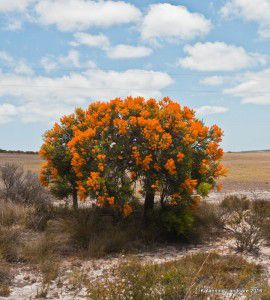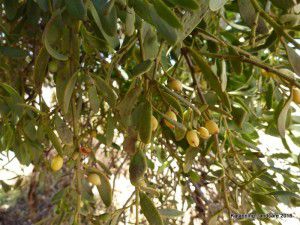Usually Mistletoe is associated with the Christmas season in the northern hemisphere.
Many people don’t realise that we have over 90 species of Mistletoe in Australia, and the largest and most spectacular is the Western Australian Christmas tree
Nuytsia floribunda.

Nuytsia floribunda

Glorious colours
Long revered by Aboriginal people as the spirit tree, Nuytsia is the only Mistletoe that grows in the ground. All others grow attached to branches. The “trunk” of Nuytsia is not wood, but a starchy material which is easily broken under the weight of the foliage and blossom.
Mistletoe plays an important role in the ecology of woodlands. They provide rich nectar and succulent berries for birds as well as secure leafy nest sites. Studies have shown if you remove Mistletoe from woodlands the number of bird species is halved. Mistletoes don’t kill their host and they are not poisonous to humans or stock.
The Mistletoe bird spreads the seeds in their droppings. Too frequent fire regime does not allow Mistletoe to establish in the woodlands.

Mistletoe fruit on a quondong

Mistletoe on acacia
In the Katanning area, broad leaved Mistletoe is commonly found on Eucalypt trees and narrow leaved Mistletoe parasitises on wattle species.
Over summer look for the Magic of Mistletoe blossom in the bush near you.
Broad-leafed Mistletoe (Dendrophthoe glabrescens) does not occur near Katanning. In WA it is only found in the Kimberley !
Nuytsia is not a mistetoe !!!. it is a root parasite. That is, it infects the roots of other plants. That it is a mistletoe is a common mis conception. Mistletoes infect the branches of other plants not their roots. I. e. Mistletoes are stem parasites. Nuytsia is a member of the family Loranthaceae, as are many of our mistletoes, but not all members of the family Loranthaceae are a mistletoes. others are Gaidendron a South American plant and Atkinsonia, which grown in the Blue mountains of NSW. (Mallees are Eucalypts but not all Eucalypts are mallees) . (The other family of mistletoes in WA is the Santalaceae (Formerly the Viscaceae) e.g, Viscum. The Santalaceae incliudes many familiar root parasites like Qandangs and Sandalwood, which are niot mistletoes for the same reason, They are root parasites.. Your other two nice pictures are the yellow fruits of Amyema miraculosa growing in Quandang (a parasite on a parasite! and Amyema preissii growing on an Acacia